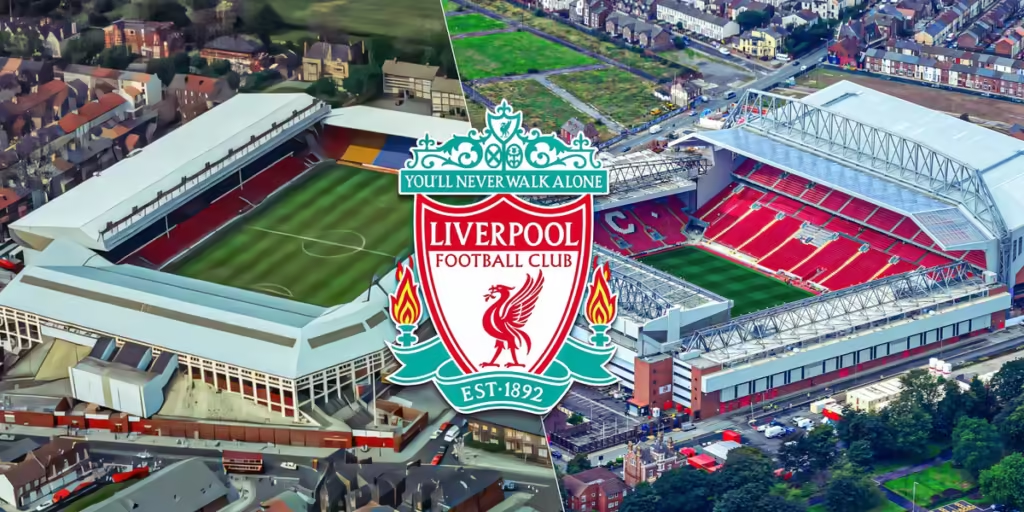Today we’re diving deep into one of the most significant stadium developments in Premier League history – Anfield’s remarkable transformation from a 45,000-capacity ground to the 61,000-seat fortress we know today.
Over the past decade, Liverpool FC has invested over £190 million in expanding their historic home, creating not just more seats, but an entirely new stadium experience. Let’s explore exactly how they did it, what it cost, and what it means for the future of Anfield.
THE ORIGINAL ANFIELD CHALLENGE
To understand the expansion, we need to go back to where it all started. By 2010, Anfield’s capacity stood at just 45,276 – significantly smaller than Old Trafford’s 74,000 or even Arsenal’s Emirates at 60,000. This size limitation was costing Liverpool millions in potential revenue each season.
The challenge wasn’t just about capacity though. The expansion sits at the heart of a master plan which links Walton Breck Road to the historic Stanley Park and forms part of a much-needed wider regeneration of the Anfield area. Liverpool faced a choice: expand Anfield or build entirely new.
When Fenway Sports Group acquired Liverpool in 2010, they committed to staying at Anfield and modernizing the historic ground. This decision would shape the next decade of Liverpool FC’s infrastructure development.
PHASE ONE: THE MAIN STAND REVOLUTION

The first phase focused on the Main Stand – Liverpool’s most ambitious stadium project since the original construction. Work began in 2015 with a bold vision: to create the largest single-tier stand in European football.
The engineering challenge was immense. The new Main Stand had to be built while the old stand remained operational for an entire season. This meant constructing around and over the existing structure – a logistical nightmare that required precise planning.
The numbers tell the story of this ambition. By adding an additional 8,500 seats, Anfield’s redevelopment saw it become one of the largest stadiums in the UK with an overall capacity of 54,000. But the real innovation was in the design.
The new Main Stand rises to 135 feet – that’s roughly equivalent to a 13-story building. It features three tiers with the upper tier alone holding 4,500 supporters. The middle tier, reserved for hospitality, adds another 2,000 seats, while the lower tier accommodates 2,000 more fans.
Beyond just seats, the Main Stand houses state-of-the-art facilities: new player tunnels, interview areas, medical facilities, and premium hospitality spaces including the 1892 Restaurant – named after Liverpool’s founding year.
However, the project came with unexpected costs. This phase proved significantly more expensive than anticipated, costing £114 million instead of £75m. The overrun was primarily due to the complexity of building around the existing structure and upgrading underground infrastructure.
The Anfield Stadium construction project was successfully completed in September 2016, in time for the start of the Premier League 16/17 season. The atmosphere that first night against Leicester City was electric – a testament to how the new stand amplified Anfield’s famous acoustics.
PHASE TWO: THE ANFIELD ROAD END EXPANSION
With the Main Stand success, attention turned to the opposite end of the ground. The Anfield Road End expansion represented phase two of Liverpool’s master plan, but it would prove even more complex than the first phase.
Planning for the Anfield Road expansion began in earnest in 2019, but the project faced unique challenges. Unlike the Main Stand, this expansion required significant community engagement due to its proximity to residential areas and Stanley Park.
The plans were approved by the Liverpool City Council in June 2021. The expansion was expected to cost £60 million and allowed Anfield Road stand to seat 7,000 more people, giving the stadium a total capacity of 61,000.
But the project encountered significant setbacks. Delays occurred when the original contractor, Buckingham Group, went into administration in 2023. This forced Liverpool to find new contractors and pushed the completion date back by several months.
The estimated cost of the construction is around £80m, although the significant delays at the start of the 2023/24 season added to this. The cost overrun meant the total project exceeded initial estimates by approximately £20 million.
The new Anfield Road End is an impressive structure in its own right. With 5,200 of these seats allocated for general admission and 1,800 for hospitality, the club has balanced accessibility with premium offerings. This split ensures that the expansion serves both traditional supporters and generates commercial revenue.
The design maintains the steep, intimidating angle that makes Anfield special while incorporating modern safety standards and accessibility features. The new stand also includes concession areas, toilet facilities, and dedicated spaces for away supporters.
THE FINANCIAL IMPACT AND REVENUE GENERATION
Let’s talk numbers. The combined expansion project has cost Liverpool approximately £194 million when you include both phases and associated infrastructure improvements. But what return does this investment generate?
Liverpool could stand to make an additional £10m per year from the expansion to the Anfield Road stand, according to James Pearce in his latest mailbag for The Athletic. Combined with revenue from the Main Stand expansion, the total additional income approaches £20-25 million annually.
This revenue comes from multiple sources: increased season ticket sales, higher match-day revenues, enhanced hospitality offerings, and non-football events. Liverpool will also apply for permanent permission to host concerts and other sporting events beyond their current agreement of six events in two years, which could see American football games held at Anfield.
For context, this additional revenue is crucial in football’s current financial landscape. With Financial Fair Play regulations and increasing competition for player transfers, stadium revenue provides a sustainable way to increase income without breaching spending limits.
CURRENT STATUS AND WHAT’S NEXT

Today, Anfield stands as a 61,000-capacity stadium – the fourth largest in the Premier League behind Old Trafford, Tottenham’s new stadium, and the London Stadium. But what’s next for Liverpool’s home?
Phase two of Liverpool’s Anfield expansion plan, which was first announced in 2014, is complete with the Anfield Road Stand taking capacity to just over the 61,000 figure. However, further expansion faces significant challenges.
If John Henry and Billy Hogan, CEO, want to invest in further redevelopment works in the coming years, then there might be some stumbling blocks. The primary constraints are the residential areas surrounding the stadium and the protected status of Stanley Park.
Any further expansion would likely require a completely different approach – potentially rebuilding existing stands rather than simply adding to them. However, with the current 61,000 capacity, Liverpool has achieved their primary objective of creating a financially sustainable stadium that preserves Anfield’s unique atmosphere.
CONCLUSION AND IMPACT ON FOOTBALL
The Anfield expansion represents more than just additional seats – it’s a case study in how historic football clubs can modernize while preserving their identity. Liverpool chose evolution over revolution, staying true to their roots while embracing the commercial realities of modern football.
The project has proved that with careful planning, community engagement, and significant investment, it’s possible to enhance a stadium’s capacity and facilities without losing what makes it special. The atmosphere at Anfield remains as inti midating as ever, perhaps even more so with 61,000 voices singing ‘You’ll Never Walk Alone.’
For other clubs considering similar projects, Liverpool’s experience offers valuable lessons: expect costs to exceed initial estimates, plan for extended timelines, and never underestimate the complexity of building around existing structures. But when done right, the results speak for themselves.
What do you think of the Anfield expansion? Have you experienced the atmosphere in the new stands? Let me know in the comments below, and if you enjoyed this deep dive into stadium development, make sure to subscribe our youtube channel for more football infrastructure content.



